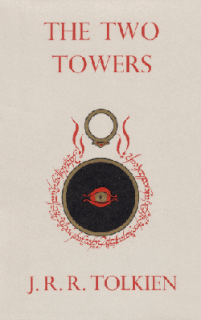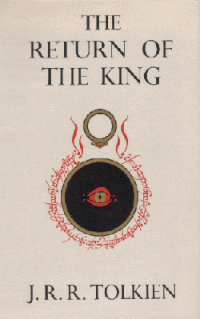Gandalf is a fictional character and a protagonist in J. R. R. Tolkien's novels The Hobbit, The Lord of the Rings and The Silmarillion. He is a wizard, member of the Istari order, as well as leader of the Fellowship of the Ring and the Army of the West. In The Lord of the Rings, he is initially known as Gandalf the Grey, but he returns from death as Gandalf the White.
Hobbits are a fictional human-like race in the novels of J. R. R. Tolkien. About half the height of humans, they are also referred to as Halflings. They live barefooted, and live in underground houses which have windows, as they are typically built into the sides of hills.
Gríma, called (the) Wormtongue, is a fictional character in J. R. R. Tolkien's The Lord of the Rings. He appears in the second and third volumes of the work, The Two Towers and The Return of the King, and his role is expanded in Unfinished Tales. He is introduced in The Two Towers as the chief advisor to King Théoden of Rohan and henchman of Saruman. Gríma serves as an archetypal sycophant, flatterer, liar, and manipulator, and is considered to be based by Tolkien on the untrustworthy character Unferth in Beowulf.

The Two Towers is the second volume of J. R. R. Tolkien's high fantasy novel The Lord of the Rings. It is preceded by The Fellowship of the Ring and followed by The Return of the King.

The Return of the King is the third and final volume of J. R. R. Tolkien's The Lord of the Rings, following The Fellowship of the Ring and The Two Towers. The story begins in the kingdom of Gondor, which is soon to be attacked by the Dark Lord Sauron.

The Lord of the Rings: The Two Towers is a 2002 epic fantasy adventure film directed by Peter Jackson, based on the second volume of J. R. R. Tolkien's The Lord of the Rings. The film is the second instalment in The Lord of the Rings trilogy and was produced by Barrie M. Osborne, Fran Walsh and Jackson, and written by Walsh, Philippa Boyens, Stephen Sinclair and Jackson. The film features an ensemble cast including Elijah Wood, Ian McKellen, Liv Tyler, Viggo Mortensen, Sean Astin, Cate Blanchett, John Rhys-Davies, Bernard Hill, Christopher Lee, Billy Boyd, Dominic Monaghan, Orlando Bloom, Hugo Weaving, Miranda Otto, David Wenham, Brad Dourif, Karl Urban and Andy Serkis. It was preceded by The Fellowship of the Ring (2001) and followed by The Return of the King (2003).
In J. R. R. Tolkien's Legendarium, the Battle of the Pelennor Fields [pɛˈlɛnnɔr] is the battle for the city of Minas Tirith between the forces of Gondor and its allies, and the forces of the Dark Lord Sauron. Tolkien recounts this battle in The Return of the King, the third volume of his 1954–55 novel The Lord of the Rings as originally printed. It is the largest battle and one of the most important events of the War of the Ring, the war in which the Third Age of Middle-earth comes to a close. It takes place on 15th 'March' T.A. 3019 in the Pelennor Fields, the townlands and fields between Minas Tirith and the River Anduin. The concept and history of composition of the battle is detailed in the fourth volume of The History of the Lord of the Rings.

The Lord of the Rings is a film series of three epic fantasy adventure films directed by Peter Jackson, based on the novel written by J. R. R. Tolkien. The films are subtitled The Fellowship of the Ring (2001), The Two Towers (2002) and The Return of the King (2003). Produced and distributed by New Line Cinema with the co-production of WingNut Films, it is an international venture between New Zealand and the United States. The films feature an ensemble cast including Elijah Wood, Ian McKellen, Liv Tyler, Viggo Mortensen, Sean Astin, Cate Blanchett, John Rhys-Davies, Christopher Lee, Billy Boyd, Dominic Monaghan, Orlando Bloom, Hugo Weaving, Andy Serkis and Sean Bean.
"The Scouring of the Shire" is the penultimate chapter of the epic fantasy The Lord of the Rings by J. R. R. Tolkien and the eighteenth chapter of The Return of the King. The hobbits, Frodo, Sam, Merry, and Pippin, return home to the Shire to find that it has been despoiled by ruffians and their leader "Sharkey", revealed to be the ex-wizard Saruman, and set things to rights.

The Return of the King, is a 1979 animated musical television film created by Rankin/Bass and Topcraft. The film is an adaptation of The Return of the King, the third and final book in The Lord of the Rings by J. R. R. Tolkien.

In 1981 BBC Radio 4 produced a dramatisation of J. R. R. Tolkien's The Lord of the Rings in 26 half-hour stereo installments. The novel had previously been adapted as a 12-part BBC Radio adaptation in 1955 and 1956, and a 1979 production by The Mind's Eye for National Public Radio in the USA.
The following outline is provided as an overview of and topical guide to the real-world history and notable fictional elements of J. R. R. Tolkien's fantasy universe.
Saruman the White is a fictional character and a major antagonist in J. R. R. Tolkien's fantasy novel The Lord of the Rings. He is leader of the Istari, wizards sent to Middle-earth in human form by the godlike Valar to challenge Sauron, the main antagonist of the novel, but eventually he desires Sauron's power for himself and tries to take over Middle-earth by force. His schemes feature prominently in the second volume, The Two Towers, and at the end of the third volume, The Return of the King. His earlier history is given briefly in the posthumously published The Silmarillion and Unfinished Tales.
Gimli is a fictional character from J. R. R. Tolkien's Middle-earth legendarium, featured in The Lord of the Rings. A dwarf warrior, he is the son of Glóin.
Peregrin Took, more commonly known simply as Pippin, is a fictional character from J. R. R. Tolkien's fantasy novel The Lord of the Rings. He is closely tied with his friend and cousin, Meriadoc Brandybuck (Merry), and the two are together during most of the story. Pippin and Merry are introduced as a pair of young hobbits who become ensnared in fellow hobbit Frodo Baggins's quest to destroy the One Ring. In this regard, Pippin is a member of the Fellowship of the Ring. He and Merry become separated from the rest of the group at the breaking of the Fellowship and spend much of The Two Towers with their own story line. Impetuous and curious, he enlists as a soldier in the army of Gondor and fights in several battles during the War of the Ring. In the epilogues to the main story, Pippin returns to the Shire and becomes Thain or hereditary leader of the land before dying and being buried as a hero in Gondor.
Théoden is a fictional character in J. R. R. Tolkien's fantasy novel, The Lord of the Rings. The King and Lord of the Mark of Rohan, he appears as a major supporting character in The Two Towers and The Return of the King. When first introduced, Théoden is weak with age and sorrow and the machinations of his top advisor, Gríma Wormtongue, and he does nothing as his kingdom is crumbling. Once roused by Gandalf, however, he becomes an instrumental ally in the war against Saruman and Sauron.
Aragorn II, son of Arathorn is a fictional character from J. R. R. Tolkien's legendarium. He is one of the main protagonists of The Lord of the Rings. Aragorn was a Ranger of the North, first introduced with the name Strider at Bree, as the Hobbits continued to call him throughout The Lord of the Rings. He was eventually revealed to be the heir of Isildur and rightful claimant to the thrones of Arnor and Gondor. He was also a confidant of Gandalf and an integral part of the quest to destroy the One Ring and defeat the Dark Lord Sauron.
Frodo Baggins is a fictional character in J. R. R. Tolkien's legendarium, and the main protagonist of The Lord of the Rings. Frodo is a hobbit of the Shire who inherits the One Ring from his cousin Bilbo Baggins and undertakes the quest to destroy it in the fires of Mount Doom. He is also mentioned in Tolkien's posthumously published works, The Silmarillion and Unfinished Tales.

The Fellowship of the Ring is the first of three volumes of the epic novel The Lord of the Rings by the English author J. R. R. Tolkien. It is followed by The Two Towers and The Return of the King. It takes place in the fictional universe of Middle-earth. It was originally published on 29 July 1954 in the United Kingdom.









